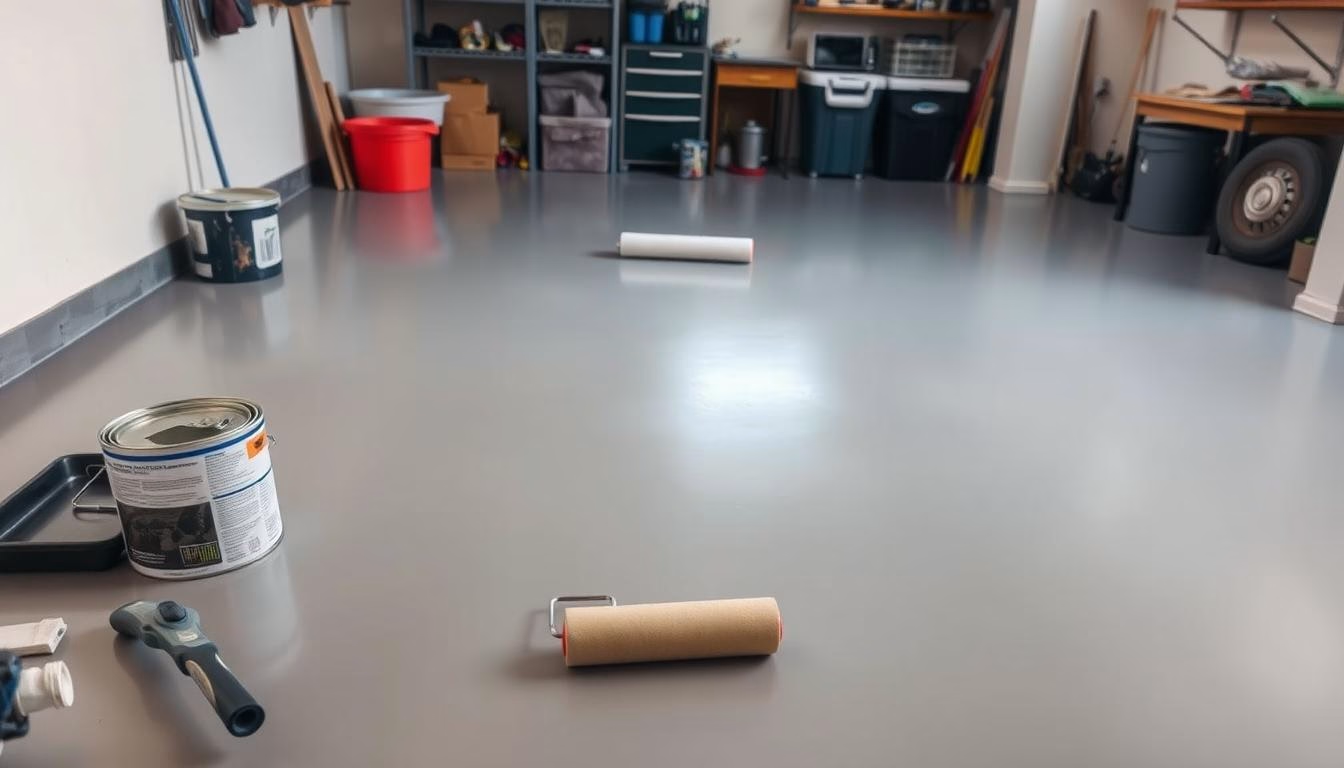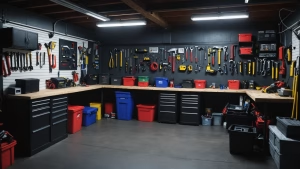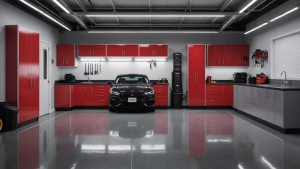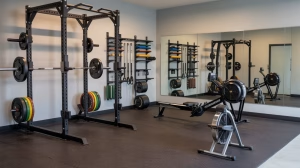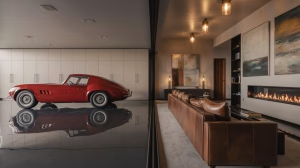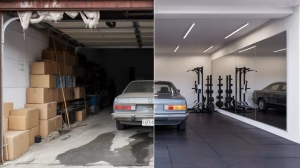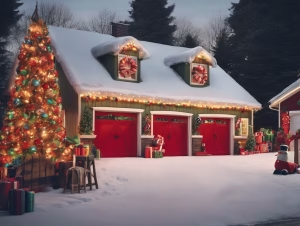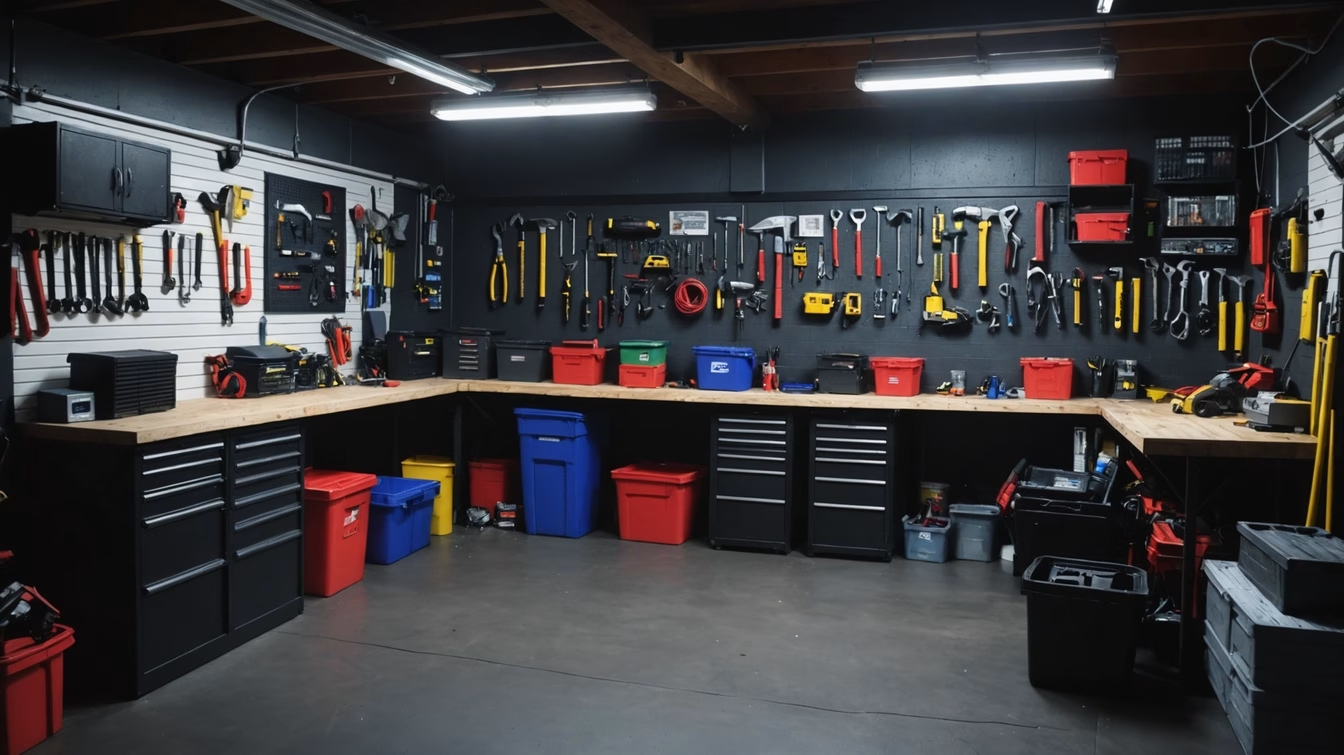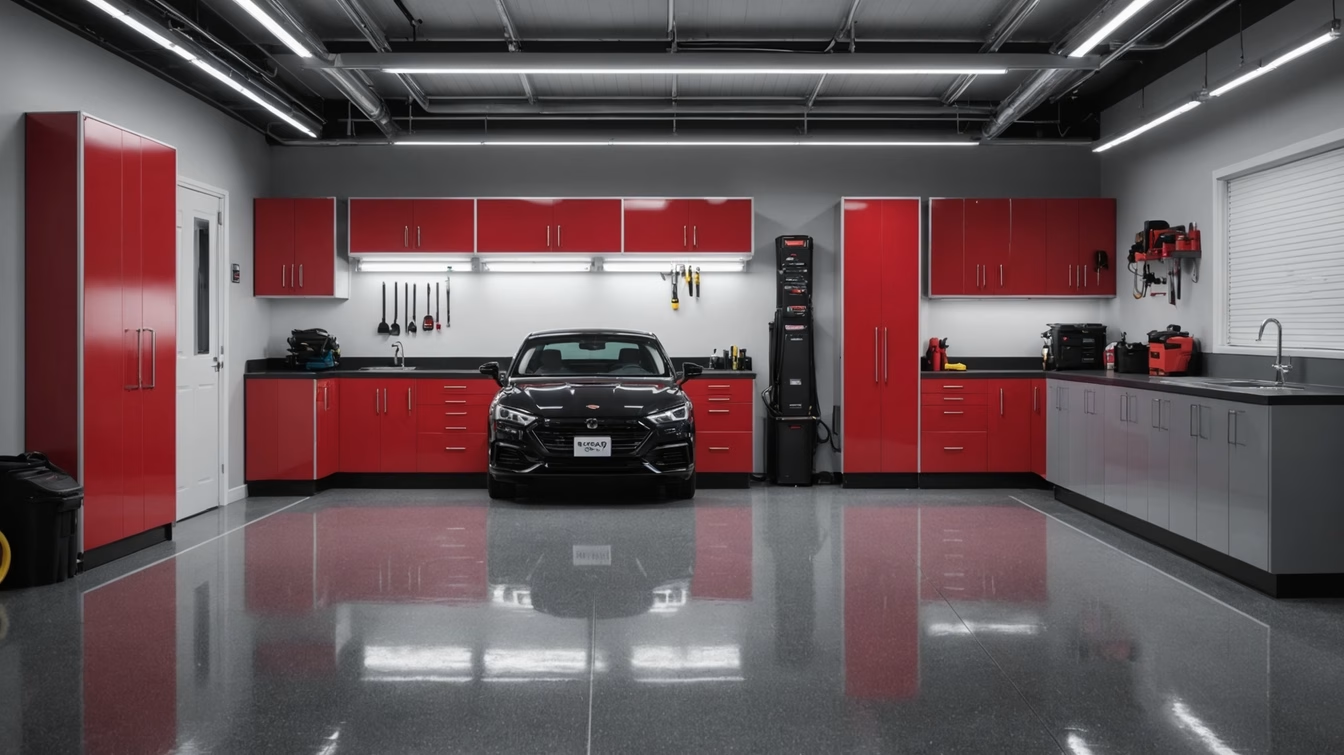Transforming your garage floor with a fresh coat of paint can greatly enhance both its appearance and durability. If you’re wondering how to paint garage floor effectively, our comprehensive guide will walk you through each step, ensuring a successful DIY project. From preparation to maintenance, follow these proven techniques and use high-quality products to achieve a flawless finish.
Whether you’re a seasoned DIY enthusiast or a beginner, painting your garage floor can be a satisfying and worthwhile home improvement project. This easy-to-follow guide will help you boost the aesthetics and longevity of your garage, making it a more pleasant and functional space.
Key Takeaways
- Preparation is crucial for achieving a smooth and durable finish.
- Choose the right type of paint for your garage floor to ensure longevity.
- Gathering the necessary tools and safety gear will make the painting process easier.
- Proper cleaning and repairing of the floor can enhance the final outcome.
- Using the correct techniques, like rolling and brushing, ensures an even application.
- Regular maintenance helps in keeping your painted garage floor looking new.
- Knowing when to repaint can sustain the durability of your garage floor.
Introduction to Garage Floor Painting
Painting your garage floor offers more than just a cosmetic upgrade. It’s a task that can be tackled by anyone, from beginners to seasoned DIYers. Knowing the benefits and the best time to paint is key to achieving great results.
Benefits of Painting Your Garage Floor
Painting your garage floor can greatly enhance its appearance. A newly painted floor can make your garage look more welcoming and organized. It also provides better protection against chemicals, oil spills, and wear and tear. This protective layer makes cleaning easier, as dirt and grime are less likely to penetrate and stain.
Moreover, a well-maintained garage floor can increase your home’s resale value. Buyers often look for a professional and durable look, which can make your property stand out in a competitive market.
Choosing the Right Time to Paint
Choosing the right time to paint is crucial for the best results. Weather conditions are key; aim for temperatures between 50°F and 80°F. Spring or fall are ideal seasons due to lower humidity, which helps paint dry faster. Ensure a weather forecast free of rain and extreme temperature changes for the best paint application and curing.
Selecting the Right Paint for Your Garage Floor
Choosing the best garage floor paint is crucial for both durability and appearance. It’s vital to know the different types of paints and their key features. This knowledge helps in selecting the right paint for your garage floor.
Types of Garage Floor Paints
Garage floor paints come in two main types: latex acrylic and epoxy. Latex acrylic paints are easy to use and dry quickly, perfect for DIY projects. In contrast, epoxy garage floor paint is more durable and resistant to chemicals, stains, and moisture. It also offers a glossy finish, enhancing your garage’s appearance.
Key Features to Look For
When picking the best garage floor paint, look for moisture resistance, chemical resistance, and ease of application. A good paint should withstand vehicle and foot traffic wear and tear. It should also be easy to clean. Anti-slip properties are beneficial, especially in areas with spills or condensation.
In conclusion, both latex acrylic and epoxy garage floor paint have their benefits. Latex acrylic paints are great for a simple, cost-effective solution. Yet, for a more durable and professional finish, epoxy paints are the better choice.
Essential Tools and Equipment Needed
Before starting your garage floor painting project, it’s vital to collect all necessary garage floor painting supplies. The right tools and equipment will greatly improve your work’s efficiency and quality.
Paint Brushes and Rollers
Choosing high-quality brushes and rollers is key to a successful garage floor paint job. Angled paint brushes are crucial for edges and corners. Rollers, meanwhile, cover large areas smoothly. They come in different nap lengths for various surface textures.
Safety Gear and Supplies
Safety is paramount in any DIY project. You’ll need durable gloves, protective goggles, and respirators to avoid fumes and chemicals. Painter’s tape and drop cloths also help keep the area clean, preventing spills and splatters. With these garage floor painting supplies, you can protect your health and achieve a flawless garage floor finish.
Preparing Your Garage Floor for Painting
Before you start painting, it’s vital to prepare your garage floor. This means a deep clean and fixing any structural issues. A well-prepared floor ensures a durable and even finish.
Cleaning the Floor Thoroughly
Start by cleaning the floor effectively. Begin by sweeping away all debris. Next, use a strong degreaser to remove oil and grease stains. After rinsing with water, let the floor dry completely before moving on.
Repairing Cracks and Imperfections
After cleaning, check for cracks and other flaws. Use a high-quality concrete filler to fix these. Apply the filler, smooth it out with a putty knife, and let it dry fully. This step is crucial for a smooth paint application and a flawless finish.
| Preparation Step | Tools/Materials Needed | Importance |
|---|---|---|
| Cleaning | Broom, Degreaser, Water | Removes debris and stains |
| Repairing Cracks | Concrete Filler, Putty Knife | Ensures smooth finish and paint adhesion |
The Best Techniques for Applying Paint
Painting a garage floor requires precision and knowledge of the best application methods. By adhering to the right garage floor painting steps, you can achieve a smooth, durable finish. This enhances both the look and functionality of your garage space.
Using a Roller vs. Brush
For painting large areas like a garage floor, a roller is often the most efficient choice. Rollers cover more surface area quickly and provide a uniform finish. Brushes, however, are better for detailed work along edges and corners. Using both tools is the best approach for comprehensive coverage in your garage floor painting steps.
Tips for Even Application
Even application is key in garage floor painting steps. Here are some tips for a flawless finish:
- Begin by pouring a manageable amount of paint into a tray to avoid overloading your roller or brush.
- Employ a ‘W’ or ‘M’ motion with your roller to distribute the paint evenly across the floor.
- Keep consistent pressure while rolling the paint to prevent streaks and uneven layers.
- For edges and corners, use a brush to carefully cut in and ensure full coverage without drips.
- Allow sufficient drying time between coats to build a resilient and long-lasting finish.
| Technique | Best For | Tips |
|---|---|---|
| Roller | Large Surface Areas | Use a ‘W’ or ‘M’ motion; consistent pressure |
| Brush | Edges and Detailed Work | Cut in carefully; avoid overloading with paint |
How to Maintain Your Painted Garage Floor
After painting your garage floor, the next step is to keep it in excellent condition. Learning the right maintenance techniques will ensure your floor stays pristine and lasts longer. Here are key garage floor cleaning tips and methods to prevent damage and wear.
Regular Cleaning Routines
Regular cleaning is essential for a painted garage floor. Begin by sweeping or using a leaf blower to clear loose debris. Then, use a mop or soft broom with a gentle cleaner made for painted surfaces. Steer clear of harsh chemicals that can damage the paint or finish.
For routine cleaning, mix water with mild dish soap. Always rinse with fresh water to avoid soap residue buildup. This approach helps maintain your floor’s appearance.
Avoiding Damage and Wear
To prevent wear and tear, minimize potential damage. Place mats or rugs at entry points to catch dirt and abrasive particles. When moving heavy objects, lift them or use protective sliders to avoid scratches.
Regularly check the floor for signs of wear, especially in busy areas. Address any issues promptly to prevent them from getting worse. By following these steps, you can effectively maintain your painted garage floor, ensuring it remains polished and durable.
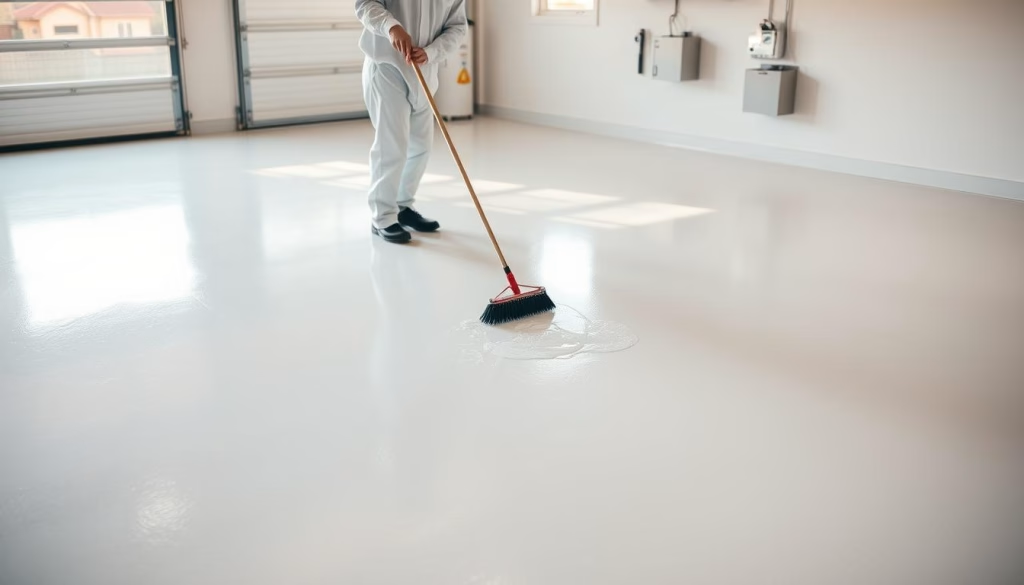
Troubleshooting Common Issues
Painting a garage floor can be challenging, affecting the final look. It’s vital for DIY enthusiasts to know how to handle these issues. Here, we tackle common problems and effective solutions.
Dealing with Paint Bubbling or Peeling
Paint bubbling or peeling is a common issue in garage floor painting troubleshooting. It usually stems from poor surface prep or trapped moisture. To fix this, make sure the floor is clean and dry before painting. Use a dehumidifier to reduce moisture and apply a concrete primer for better paint adhesion.
Fixing Mistakes During Application
Incorrect painting techniques can cause uneven paint or visible brush strokes. In garage floor painting troubleshooting, following best practices is key. Use a high-quality roller for big areas and a brush for edges and corners. Keep a wet edge to prevent marks and paint in small sections for a smooth finish.
When to Repaint Your Garage Floor
Identifying the perfect moment to repaint your garage floor is essential for its longevity and appearance. Spotting the signs and timing it right can streamline the process, making it cost-effective and stress-free.
Signs That It’s Time for a Fresh Coat
A well-maintained garage floor enhances your space’s value and appeal. However, wear and tear will eventually show. Here are the key indicators that it’s time for a new coat:
- Fading Color: As paint ages, it loses its original color due to sunlight and frequent use.
- Peeling and Flaking: Visible peeling or flaking paint signals the need for a garage floor repaint.
- Stains and Oil Spots: Persistent stains and oil spots that can’t be removed are a sign for a repaint.
- Surface Damage: Cracks, chips, or dents on the painted surface indicate it’s time for a refresh.
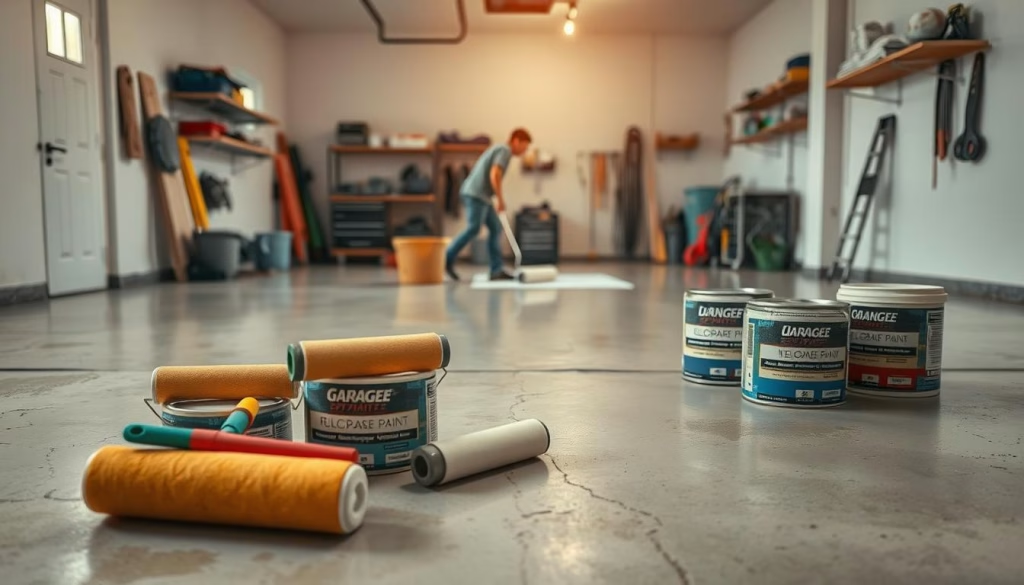
Planning for Reapplication
Proper planning ensures a seamless garage floor repainting project. Consider these steps:
- Budgeting: Evaluate the painting cost, including materials, tools, and professional services, to ensure sufficient funding.
- Scheduling: Opt for a time with good weather, avoiding extreme temperatures that can impact paint application.
- Prep Work: Allow enough time for thorough cleaning and damage repair, essential for a lasting finish.
- Choosing Quality Products: Invest in top-notch paint and supplies for durability and a superior finish.
By keeping these points in mind, you can manage the painting cost effectively and achieve a successful repaint project.
Conclusion and Final Tips for Success
As we conclude our guide on painting your garage floor, it’s evident that this journey can be both rewarding and transformative. Whether aiming to enhance your garage floor paint colors or simply refresh your garage, the steps we’ve outlined will guide you to success. Let’s recap the essential points and share some final tips to boost your confidence in this DIY endeavor.
Recap of Essential Steps
We’ve detailed every critical stage, from picking the right garage floor paint to the necessary tools and preparation for the best results. First, selecting the right paint type, focusing on durability and finish, is crucial. Next, ensuring your garage floor is clean and any imperfections are fixed is key. Then, apply the paint with the correct techniques and tools, maintain the surface, and know when to repaint for lasting beauty.
Encouragement for DIY Painters
Embarking on a garage floor painting project might seem daunting, but with proper planning and DIY success tips, it’s doable. Approach the task with patience and a focus on detail for professional-quality outcomes. Even if issues arise, there are solutions to fix them. So, gather your tools, allocate sufficient time, and start this rewarding home improvement project. Not only will you enhance your space, but you’ll also gain valuable DIY experience.

